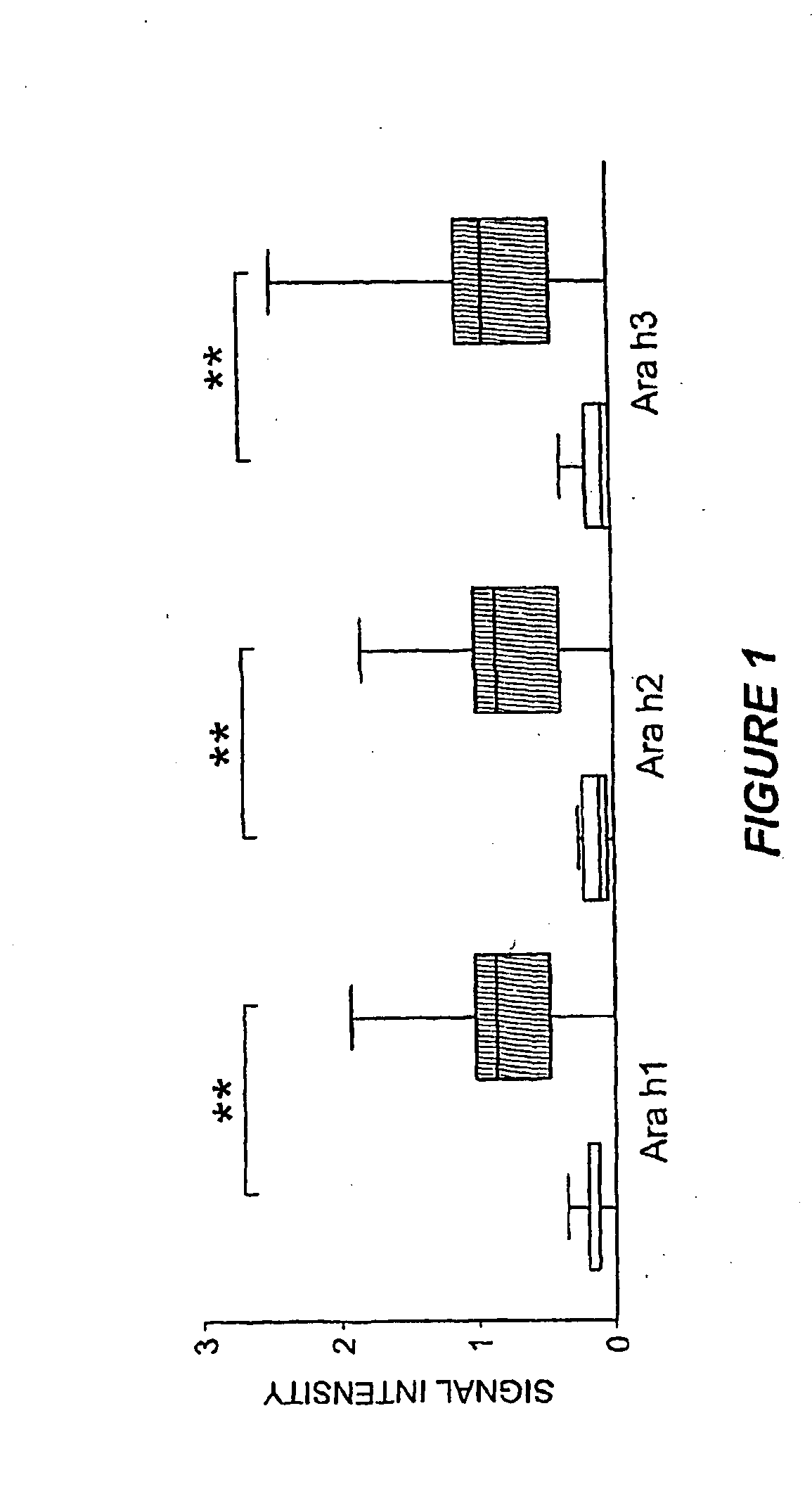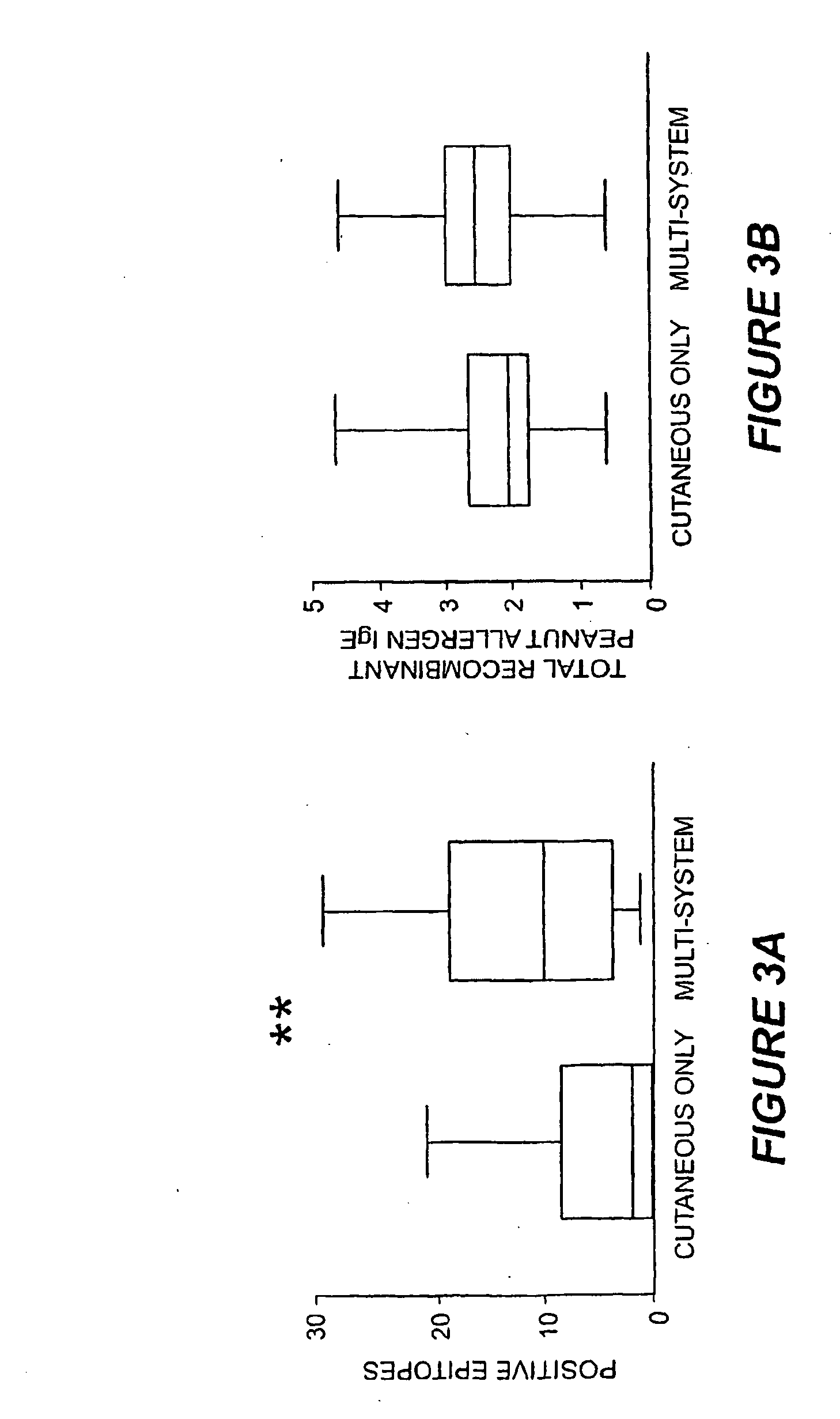Methods of determining allergen response using microarray immunoassay techniques
a technology of immunoassay and microarray, which is applied in the field of determining the response of allergens using microarray immunoassay techniques, can solve the problems of cardiac collapse, failure to thrive, and severe impact on the quality of life of adults
- Summary
- Abstract
- Description
- Claims
- Application Information
AI Technical Summary
Benefits of technology
Problems solved by technology
Method used
Image
Examples
example 1
Materials and Methods
[0104]The present example provides exemplary methods and materials used in the preparation and testing of a microimmunoassay for determining the severity of an allergic response.
[0105]Collection and Processing of Patient Sera. Patient and control sera were selected retrospectively on the basis of detectable IgE to peanut as measured by Pharmacia Cap System FEIA. Patients that exhibited some history of food allergenicity were recruited and detailed food reaction histories were prepared. Medical records were reviewed for history of reaction frequency and symptoms. Reaction severity was ranked on a scale of 0 to 6 as described previously (Sampson, Pediatrics, 111:1601-8, 2003). The age of peanut sensitized individuals at the time of recruitment ranged from 1.5 to 36 years (median 6.9 yrs, n=57). Peanut-specific IgE ranged from 1.97 to >100 kU / L (median >100). Of these patients, 38 had a history of positive DBPCFC or convincing history of clinical reaction. The rema...
example 2
Assay Validation
[0113]In order to assess assay characteristics, replicate experiments were performed using a pool of peanut-allergic patient sera to investigate inter- and intra-assay reproducibility. Each array also included whole recombinant Ara h1, Ara h2 and Ara h3. The same pooled sera were applied to four separate arrays. Intra-assay coefficient of correlation for any one of the four assays was >0.95 and the variance was homogenous. The inter-assay mean coefficient of variation for peptide binding was 3.4% with a range of 0.1% to 14%, which correlated with intensity of staining.
[0114]Ara h1, Ara h2 and Ara h3 have been previously described as major peanut allergens (Rabjohn et al., J. Clin. Invest., 103:535-4210, 1999; Burks et al., J. Allergy Clin. Immunol. 88(2):172-9, 1991; Burks et al., J. Allergy Clin. Immunol., 90:962-9, 1992). The MIA described herein allowed examination of the prevalence of IgE recognition of these allergens for a large number of patients (n=77). Consi...
example 3
Diagnostic Findings
[0119]A striking feature of IgE binding revealed by MIA is the variability from patient-to-patient with respect to both the number of peptide epitopes recognized and the pattern of recognition. FIG. 2B shows eight representative graphs, plotting signal against peptide, that demonstrate this large degree of heterogeneity. These data demonstrate that the MIA methods used herein can be used to produce a map of an individual subject's heterogeneous patterns of IgE binding to various allergens. Such mapping will assist in therapeutic and prophylactic intervention of allergic responses of the subjects. In particular, the methods described herein demonstrate that greater IgE diversity with respect to epitope recognition corresponds to a history of greater reaction severity such that greater epitope diversity is a marker for more severe allergic reactions. Food antigen-specific IgE concentrations alone have been shown to have prognostic value for likelihood of reactivity ...
PUM
| Property | Measurement | Unit |
|---|---|---|
| temperatures | aaaaa | aaaaa |
| wavelengths | aaaaa | aaaaa |
| wavelengths | aaaaa | aaaaa |
Abstract
Description
Claims
Application Information
 Login to View More
Login to View More - R&D
- Intellectual Property
- Life Sciences
- Materials
- Tech Scout
- Unparalleled Data Quality
- Higher Quality Content
- 60% Fewer Hallucinations
Browse by: Latest US Patents, China's latest patents, Technical Efficacy Thesaurus, Application Domain, Technology Topic, Popular Technical Reports.
© 2025 PatSnap. All rights reserved.Legal|Privacy policy|Modern Slavery Act Transparency Statement|Sitemap|About US| Contact US: help@patsnap.com



